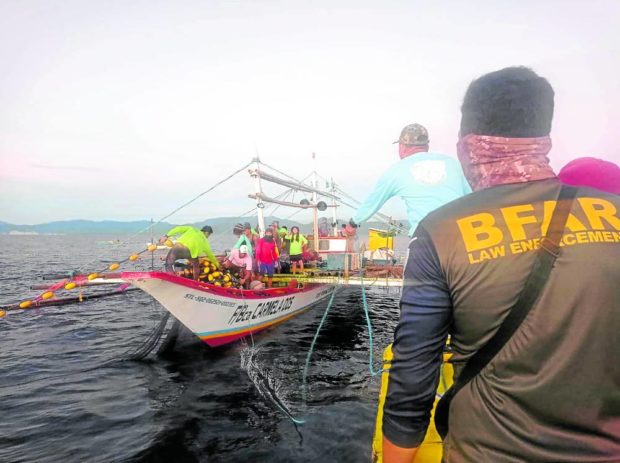Rampant illegal fishing in Quezon waters alarms group

RING NETS Government law enforcers apprehend on May 29 suspected illegal fishers allegedly using “taksay” (ring nets) off the island of Alabat in Lamon Bay, Quezon. —PHOTO COURTESY OF DANILO LARITA JR.
LUCENA CITY—Rampant destructive fishing methods were again reported in the bays of Tayabas and Lamon in Quezon province, prompting an environmental group to urge the local government to curb the illegal activities.
Jay Lim, project officer of Tanggol Kalikasan (TK), said the resurgence of illegal fishing activities was confirmed by a local fisherman in this city’s coastal village of Dalahican along the Tayabas Bay. TK is a public interest law office that advocates environmental protection.
A local fisherman, who spoke on condition of anonymity, blamed the presence of large commercial fishing operations for the dwindling catch in the bay area.
“Sad to admit that there are some of us who were forced to (engage in) illegal fishing. I can’t blame them,” the fisherman told the Inquirer in an interview on Thursday.
On June 1, three illegal fishing boats known as “buli-buli” (modified Danish seine) that operated in the municipal water of Pagbilao town fronting Tayabas Bay were apprehended by combined operatives from the Bureau of Fisheries and Aquatic Resources, the Philippine Navy and the Philippine Coast Guard, Lim said in a separate interview.
Article continues after this advertisementLate last month, government authorities also stopped the operations of commercial fishers whose three boats used destructive “taksay” (ring nets) off the island of Alabat in Lamon Bay in the Pacific Ocean, Lim added.
Article continues after this advertisementMore support needed
The Quezon police have also been reporting the daily arrest of illegal fishers in Tayabas and Lamon bays.
Lim said other destructive fishing methods using “pangulong” (purse seines), dynamite and cyanide were also happening at the bays.
“TK has always been a supportive and active partner of government agencies to stop illegal and destructive fishing methods. But it seems that our combined efforts need more support,” he admitted.
Lim called on all local government officials here to take decisive actions to stop illegal fishing.
“With the rising cost of living, more fishers—legitimate and illegal—will resort to unlawful activities just to earn and the heck with the environment,” Lim said.
Protection
Thirty-four of Quezon’s 42 towns are coastal—17 along Lamon Bay in the Pacific Ocean, 12 off the Tayabas Bay facing the China Sea and five along the Ragay Gulf.Lim stressed that protecting the rich marine resources of Tayabas Bay from illegal fishing is a serious concern.
“For the first time, a hawksbill sea turtle, which is classified as critically endangered, has been recently spotted in the bay. A whale shark has also been sighted,” Lim disclosed.
He said their continuous monitoring also showed that the fish sanctuaries in Tayabas Bay were again showing life, as sea turtles, manta rays and assorted fish species have started to return to the areas.
The Tayabas coastline in Sariaya town serves as a sanctuary for turtles that usually come to lay and hatch their eggs from October to December.
Fishermen, fish wardens and local government workers were trained to care for the hatchlings of different sea turtle species in five nesting sites.
Deadly threats
But numerous “baklad” or huge stationary fish traps sunk into the bottom of the bay pose deadly threats to the marine turtles, a number of whom had been found dead along the beach from suffocation after getting entangled in fish traps.
Coral reef poachers also threaten the marine life at the bay, in some instances involving the fishermen who needed to augment income lost to commercial fishers.
Years of illegal and commercial fishing and pollution have damaged Tayabas Bay, which covers 287,332 hectares, according to a TK study.
The depletion of marine resources in Lamon Bay in northern Quezon and Tayabas Bay covering parts of Quezon, Marinduque and Batangas provinces has long been the subject of concern among environmentalists.
RELATED STORY: